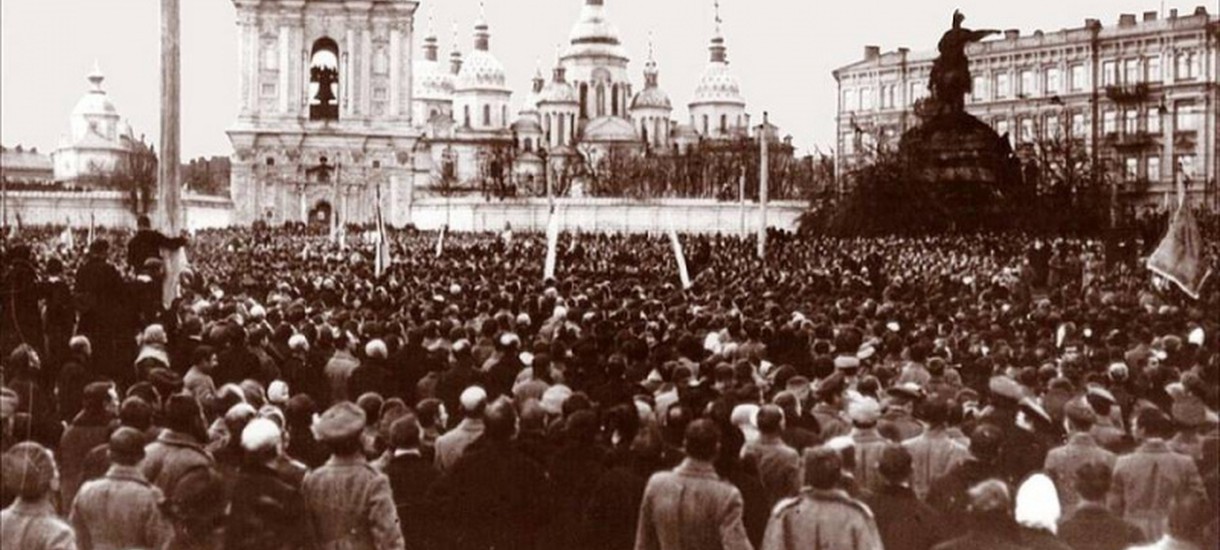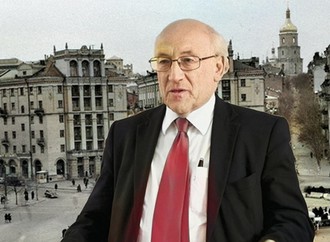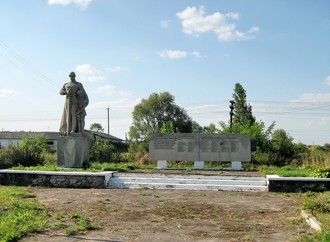Putin’s Russia is raining destruction down on the citizens and infrastructure of Ukraine, supposedly in the name of the “denazification” of the country. The Russian president and his propaganda machine have been greatly exaggerating the strength of neofascist trends there, often brazenly lying. One can get the impression that the entire movement to develop Ukrainian culture and to secure an independent state is tainted by fascism. As a corrective to such notions, this article briefly surveys the history of the socialist movement in Ukraine.
Modern Ukrainian politics was born in Kyiv in the 1860s and 1870s. The city then hosted a mix of nationalities – Russians, Poles, Jews, and Ukrainians. The Ukrainians, mainly students and young intelligentsia, gathered around an organization called the Hromada. The word means «community» in Ukrainian. The most dynamic leader of the Hromada was Mykhailo Drahomanov, a brilliant political thinker and polemist. In his analysis, class and ethnicity tended to be congruent on Ukrainian territories. The large landowners were Poles, Russians, or Russophone ethnic Ukrainians. The craftsmen and merchants were primarily Jewish, religiously traditional and Yiddish-speaking. But the peasants, who made up the vast majority of the population in this «breadbasket of Europe», spoke the Ukrainian language and maintained a culture distinct from the other nationalities. The peasants therefore, said Drahomanov, were to form the basis of the Ukrainian movement, and the intelligentsia, which had been educated in Russian or Polish, had the obligation to learn to write in Ukrainian in order to spread ideas of enlightenment and progress in the countryside.

Mykhailo Drahomanov
Drahomanov embraced progressive ideals and believed that all of Europe was marching towards socialism and, in his opinion, also towards anarchism. When the Russian autocracy cracked down on the Ukrainian movement in the mid-1870s, he was forced into exile, first to Switzerland and later to Bulgaria. In Geneva Drahomanov published the first Ukrainian socialist journal, named Hromada. He leaned more towards Bakunin than to Marx, but some of his closest associates leaned the other way. Serhii Podolynsky actually corresponded with Marx, and Mykola Ziber wrote a long treatise on Marx’s Capital. Drahomanov was also a consistent opponent of the early manifestations of Ukrainian ethnonationalism. He himself did not conflate his pro-Ukrainian sympathies with antipathy towards the other nationalities of Ukraine. He did, however, oppose chauvinistic tendencies in both the Polish and Russian revolutionary movements.
Drahomanov also ignited the socialist movement in those Ukrainian territories that were then part of the Habsburg monarchy, in particular in the crownland of Galicia, with its capital in Lviv. Among the Ukrainian students he converted to socialism was the poet, novelist, and scholar Ivan Franko, often regarded as the second most important Ukrainian literary figure after the national bard Taras Shevchenko. The Galician socialists founded the peasant-oriented Radical Party in 1890. Drahomanov was a prolific contributor to their newspaper Narod (The People) until his untimely death in 1895 at the age of fifty-three. Before the 1890s were finished, younger Radicals split off from their party to found the Ukrainian Social Democratic Party, which represented the easternmost outpost of Austromarxism [one of these young Marxists, Yulian Bachynsky, was actually the first theoretician to rationalize the demand for independence of Ukraine as a separate modern state – Ed.]. The Radicals supported strikes by Ukrainian agricultural workers, and the annual Mayday demonstration in Lviv drew huge crowds.
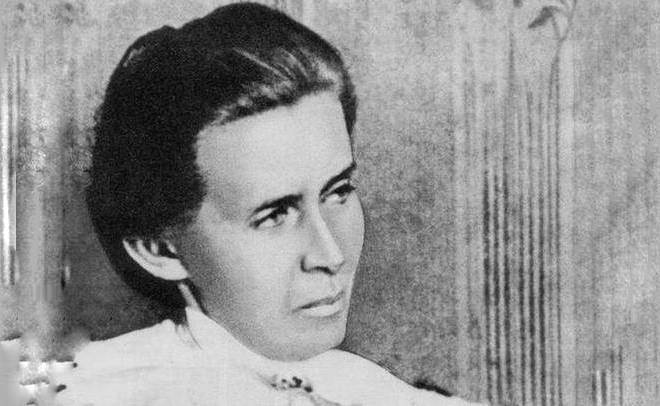
Lesya Ukrainka, Ukrainian literature's foremost female voice, was also an activist of an early feminist and socialist movements. Influenced by both Marxism and her uncle Drahomanov's version of socialism, she co-founded a group called Ukrainian Social Democracy [Ed.].
In Lviv and other cities in Western Ukraine at the turn of the twentieth century there emerged socialist groups in institutions of secondary and post-secondary learning called «Drahomanov Circles». These drahomanivky, as they were known in Ukrainian, evolved ever leftward, eventually ending up in the Zimmerwald anti-war camp during the First World War. They greeted the Bolshevik revolution in Russia, and from their cadres came the founders of the Communist Party of Western Ukraine.
Ukrainians in Kyiv and elsewhere in the Russian empire suffered from a lack of basic civil rights, such as freedom of the press and assembly; moreover, there were severe restrictions on publications in the Ukrainian language and a total ban on the Ukrainian language in education. But in the 1890s, Ukrainian students began to revivify political activity, establishing the Revolutionary Ukrainian Party in 1900. The party was ideologically rather inchoate, and it split into several parties in 1904, including the Ukrainian Social Democratic Workers’ Party (USDRP) and the Ukrainian Social Democratic Spilka (Association). Both parties were Marxist but divided over the national question. Divisions over how much attention to pay to nationality were a chronic source of tension within the Ukrainian socialist movement. Lev Yurkevych – a funder, central committee member, and theoretician of the USDRP – espoused positions close to that of Lenin, but polemized with him in regard to the national question.
With the outbreak of revolution in 1917, a Ukrainian Socialist Revolutionary Party was founded in Ukraine. Like the Russian SRs, they were socialists who advocated a peasant revolution rather than a workers’ revolution. The Ukrainian Social Democrats and Socialist Revolutionaries were the main constituents of the Ukrainian Central Rada, Ukraine’s revolutionary parliament. Conflict between the Rada and the Bolsheviks broke out in 1917, but some Ukrainian revolutionaries formed pro-Bolshevik groups, namely the Borotbists (left offshoots of the SRs) and the USDRP Independentists ultimately establishing their own communist parties separate from the Bolsheviks. Another significant peasant revolutionary force was the Revolutionary Insurgent Army of Ukraine with its anarcho-communist commander Nestor Makhno. After the civil war [and the victory of the Red Army led by Ukrainian-born Leon Trotsky – Ed.], most of the Ukrainian territories that had been located in the former Russian empire were incorporated into Soviet Ukraine. All Ukrainian parties were then banned except for the Communist Party (Bolshevik) of Ukraine [what remained of independent Ukrainian and Jewish left-wing parties here was absorbed by the CP(b)U – Ed.].
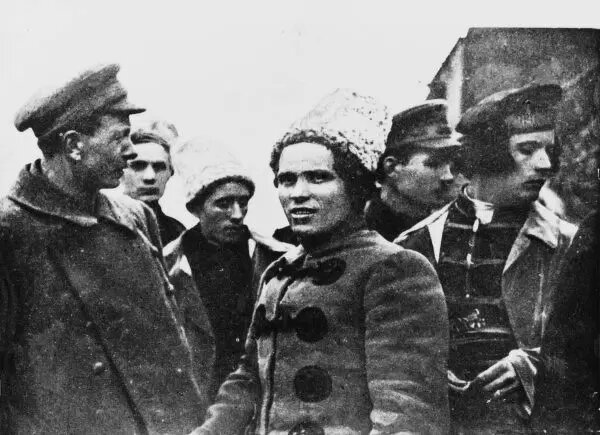
Another significant peasant revolutionary force was the Revolutionary Insurgent Army of Ukraine with its anarcho-communist commander Nestor Makhno [Ed.].
The 1920s saw a flourishing of Ukrainian communism. Galicia, which had once been part of Austria, and Volhynia, which had formerly been part of the Russian empire, were now annexed by Poland. Many Ukrainians in Galicia were Sovietophiles in the 1920s, following events in Soviet Ukraine with great interest. While they were suffering discrimination in Poland, Ukrainian cultural, scholarly, and educational institutions were developing with state support in Soviet Ukraine. Quite a few Galician Ukrainian intellectuals made the mistake of migrating to Soviet Ukraine for work that suited their talents, such as in scholarly institutions and encyclopedia projects. All of them were murdered by the Stalinist regime in the 1930s. In Volhynia, where there was a thinner layer of educated Ukrainians as a result of former tsarist policies, communism remained a powerful force among the peasantry even into the 1930s.
Cultural ferment in Soviet Ukraine in the 1920s was remarkable. It was a period when so-called national communists were developing avantgarde art, literature, and theater and carrying on a lively program of scholarship into Ukrainian history and other social sciences. The 1920s were the decade of Ukrainianization, the Ukrainian variant of the indigenization (korenizatsiia) that was for a while the policy throughout the Soviet Union. In cultural matters, Soviet Ukraine was basically following its own unique path, and interest in what they achieved has never lagged.
The Bolshevik revolution also had a major impact on Ukrainians who had migrated to North America. Pro-Bolshevik periodicals and organizations proliferated among miners and laborers in Canada and the US.
And then a murderous darkness descended. The 1930s was the quintessential Stalinist decade. The Ukrainianization policy was formally ended. Rapid collectivization resulted in a terrible famine in 1932-33, with the worst effects displaced to Ukraine. Almost four million people in Ukraine died from that famine. Prominent national communists like the commissar of education Mykola Skrypnyk and the proletarian writer Mykola Khvyliovy were driven to commit suicide. Numerous purges over the course of the 1930s resulted in the imprisonment and execution of almost all of Ukraine’s national communist elite.
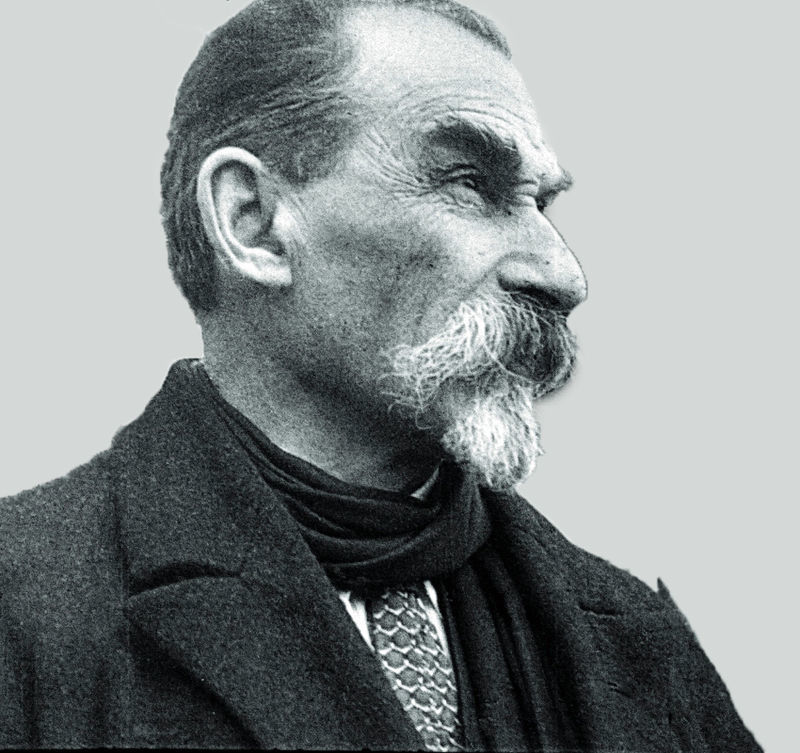
As commissars of education of Soviet Ukraine, Mykola Skrypnyk (pictured), one of the prominent Old Bolsheviks, and his predecessor Oleksandr Shumsky, a former Borotbist leader, were major proponents of the 1920s Ukrainian cultural revival [Ed.].
The terrible events in Soviet Ukraine certainly erased the Sovietophilism that had existed earlier in Galicia in Poland. Socialist parties continued to exist there, but they were horrified by what they learned about the Ukrainian territories just across the Soviet border. A miniscule left communist/national communist group was based in Lviv in the 1930s and was able to publish a short-lived journal. In 1939, as a result of the German-Soviet Nonaggression Pact, the Soviets annexed Western Ukraine, that is, the territories of Galicia and Volhynia in Poland. All political parties were dissolved or dissolved themselves, and they did not revive their activities under the Nazi occupation (1941-44). The only political organization that survived both the Soviet and Nazi interlude was the right-wing Organization of Ukrainian Nationalists. It drew on a long experience of underground conspiratorial work. But before the Soviets even began to arrest Nationalists, the NKVD hunted down and executed the few dissident communists that had remained on the territory of Western Ukraine.
Although socialist activity was largely moribund on Ukrainian lands after the 1920s, there was a remarkable Ukrainian socialist who managed to survive all the persecutions of the Soviet and Nazi periods, eventually passing away in Detroit in 1967. This was Roman Rosdolsky. He had converted to socialism as a youth in the Drahomanov Circle in Lviv. He became a member of the Communist Party of Western Ukraine and also one of the small anti-Stalinist group of left communists active in Polish-ruled Galicia in the 1930s. When the Soviets took Western Ukraine in 1939, he fled to Kraków in the German zone. He was arrested for helping Jews who fled from the ghetto and was incarcerated in Auschwitz for these activities. After the war he moved to Detroit and worked on a brilliant interpretation of Marxist economic thought, The Making of Marx’s Capital. The basis of this interpretation was a close comparison of Marx’s Grundrisse with Capital. He also wrote an important work on the national question: Engels and the ‘Nonhistoric’ Peoples. Born in a region where the Ukrainian, Polish, German, and Russian languages intersected, Rosdolsky was comfortable working in all the classical texts of Marxism, works by Marx and Engels, Lenin and Rosa Luxemburg.
After World War II, there were still some manifestations of Ukrainian socialist thought. In emigration, a group of surviving national communists as well as former Nationalists who had moved to the left, gathered around the newspaper Vpered (Forward), which came out from 1949 to 1959. Among them were some impressive luminaries: Borys Lewytzkyj, an outstanding Kremlinologist; Vsevolod Holubnychy, a political philosopher and economist; and Ivan Majstrenko, a former Borotbist. Under the impact of the antiwar movement in America and radical politics in both the USA and Canada, a group of young people of Ukrainian heritage in Canada published the Ukrainian-language journal Diialoh, the motto of which was «Socialism and democracy in an independent Ukraine». It came out from 1977 until 1987. Members of the Diialoh group were in contact with the aging members of the Vpered group.
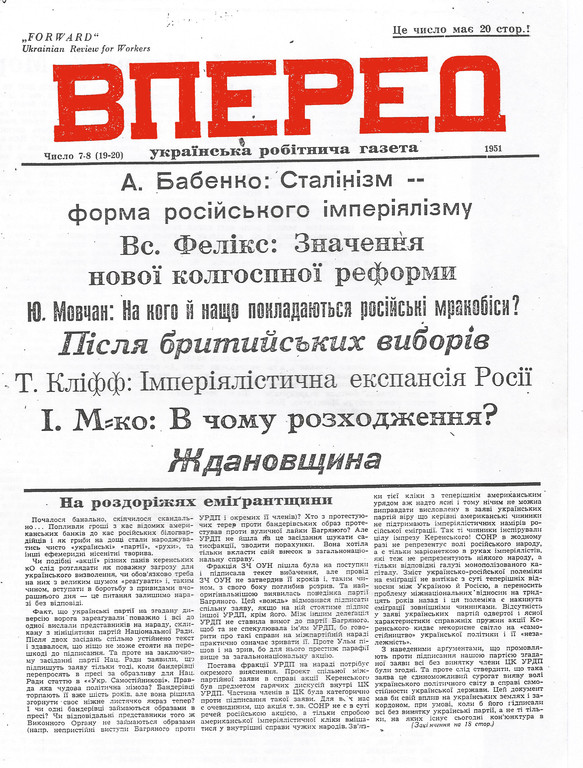
The newspaper Vpered of post-war Ukrainian Revolutionary Democtratic Party in the diaspora, with a translation of Tony Cliff on Russian Imperialism.
Socialist thought also informed some of the dissidents who were persecuted in Soviet Ukraine. A notable example is Ivan Dzyuba’s book Internationalism or Russification, which he wrote in 1965. A critique of post-Stalinist Soviet nationality policy from Marxist positions, it circulated in manuscript in Ukraine and could only be published in the West. Leonid Plyushch was a mathematician arrested for dissident activities in 1972. The Soviet authorities locked him up in a mental hospital and fed him with drugs. A massive campaign in the West for his release resulted in his being able to move to France in 1976. There he wrote a memoir, History’s Carnival, in which he described his imprisonment and also advocated a humanist Marxism.
The socialist and workers’ movement in contemporary Ukraine has too many organizations and websites for even a brief description here. Fortunately, the socialist Ukraine Solidarity Campaign in London has provided a list of links to the major sites [this list needs to be updated – Ed.].
